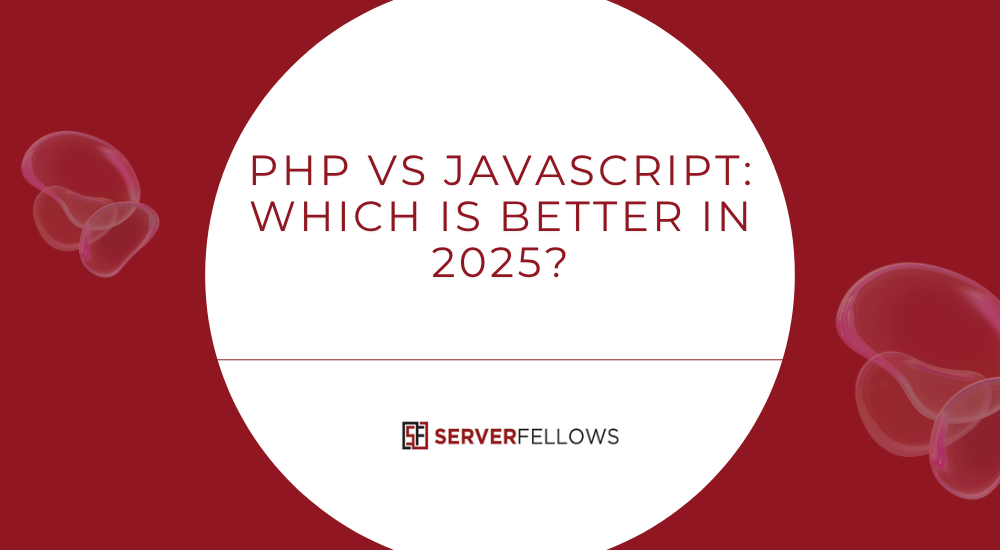
PHP vs JavaScript: Which Reigns Supreme?
When it comes to web development, the PHP vs JavaScript debate remains one of the most discussed topics among developers and businesses alike. Both languages are essential pillars of modern web architecture, each offering unique advantages that cater to different needs. Whether you’re building a data-heavy content platform, an interactive web app, or a full-stack solution, understanding the strengths and weaknesses of PHP and JavaScript can guide you to the right choice.
Key Takeaways
- Neither language universally reigns supreme — each excels depending on the project scope and architecture.
- PHP is powerful for server-side rendering, secure transactions, and CMS-driven sites.
- JavaScript dominates interactive front ends, real-time applications, and full-stack environments using Node.js.
- Both languages can coexist harmoniously in hybrid setups for maximum performance.
- Scalability, performance, and security depend more on design choices than on language limitations.
The PHP vs JavaScript Dilemma
The PHP vs JavaScript dilemma stems from the environments where each language thrives. PHP, born in 1994, was designed for server-side scripting, while JavaScript, introduced a year later, began as a browser language before expanding into full-stack territory.
Organizations weigh both options based on factors such as scalability, developer familiarity, community support, and long-term maintainability. Some prefer PHP’s predictable architecture and simplicity; others lean toward JavaScript’s flexibility and asynchronous nature.
The decision isn’t about which language is better, but which one aligns with your team’s goals, project type, and user experience vision. At Serverfellows.com, many hosting clients blend both technologies for balanced scalability and interactivity — achieving the best of both worlds.
Core Strengths and Use Cases
PHP: The Backend Powerhouse
PHP shines in areas requiring robust server-side rendering and structured content management. Its request–response model, combined with frameworks like Laravel or Symfony, makes it ideal for content-heavy websites and applications that rely on reliable data transactions.
Common PHP use cases include:
- CMS platforms (WordPress, Drupal, Joomla)
- E-commerce portals with transactional backends
- Membership systems and secure dashboards
- Templated page generation with predictable load times
PHP’s simplicity and hosting compatibility — especially when paired with optimized environments like Serverfellows — make it a practical choice for startups and enterprises alike.
JavaScript: The Front-End and Full-Stack Champion
JavaScript dominates interactive and real-time experiences. Initially confined to browsers, it now powers the full stack through Node.js and frameworks like React, Angular, and Vue.
Key JavaScript applications include:
- Single Page Applications (SPAs)
- Real-time chat, dashboards, and collaboration tools
- Streaming services and microservices
- Event-driven serverless backends
Its asynchronous, non-blocking architecture allows it to handle thousands of concurrent connections, making it an excellent fit for dynamic web environments.
Syntax, Paradigms, and Learning Curve
The syntax of PHP and JavaScript may appear similar on the surface, but their underlying paradigms differ significantly.
PHP uses a procedural and object-oriented approach. It follows a traditional, synchronous pattern — every request executes and returns a response independently. Beginners often find this easier to grasp because of its linear logic flow and built-in templating capabilities.
JavaScript, meanwhile, emphasizes functional and event-driven programming. Concepts like closures, asynchronous calls, and promises can be challenging for newcomers, but they enable unmatched flexibility once mastered.
For developers transitioning from static websites to modern web apps, learning both languages can open powerful integration possibilities — especially if deployed on an optimized stack through hosting providers such as Serverfellows.com.
Performance and Runtime Considerations
Performance in the PHP vs JavaScript comparison depends heavily on runtime design and the type of workload.
PHP Performance Highlights:
- Executes per request under a shared-nothing model.
- Uses OPcache and Just-in-Time (JIT) compilation (PHP 8) to boost speed.
- Ideal for synchronous, content-serving operations.
JavaScript Performance Highlights:
- Node.js operates on a single-threaded event loop with non-blocking I/O.
- Handles concurrent, real-time operations efficiently.
- Excels in scenarios requiring constant client-server communication.
Both scale horizontally through load balancing, caching, and CDN integration. In practical environments, performance gains are achieved through architecture rather than language choice — and platforms like Serverfellows.com provide optimized configurations for both PHP and JavaScript applications.
Security Posture and Best Practices
Security is a critical factor in choosing between PHP and JavaScript. The architectural difference influences how vulnerabilities are mitigated.
PHP Security Advantages:
- Centralized server-side execution ensures consistent patching and controlled environments.
- Built-in defenses for SQL injection, CSRF, and XSS (especially in frameworks).
- Mature security libraries and community guidelines.
JavaScript Security Challenges:
- Runs both on client and server, expanding the attack surface.
- Requires vigilant protection against XSS, dependency risks, and supply-chain attacks.
- Best secured with content security policies (CSPs), dependency audits, and sandboxed execution.
In either case, proactive security updates, encrypted connections, and automated backups — services often bundled by Serverfellows.com — are essential for sustainable operations.
Scalability and Architecture Patterns
Both PHP and JavaScript can scale effectively, but their approaches differ.
PHP Scalability:
- Scales horizontally using multiple instances and caching layers.
- Pairs well with Redis, Memcached, and Varnish for faster response times.
- Frameworks promote Model-View-Controller (MVC) design for modularity.
JavaScript Scalability:
- Leverages event-driven microservices, perfect for cloud-native setups.
- Ideal for scaling real-time data handling with Node clusters and containerization.
- Integrates seamlessly with serverless functions and APIs.
Whether deploying monolithic or microservice-based systems, robust hosting environments like Serverfellows provide the infrastructure needed to scale efficiently.
The Power of a Hybrid Stack
A hybrid approach can often yield the best outcomes. Many modern applications combine PHP for server-side stability with JavaScript for dynamic user interaction.
How it works:
- PHP handles data processing, authentication, and rendering templates.
- JavaScript enhances the interface with AJAX calls, websockets, and SPA frameworks.
- APIs bridge both worlds through REST or GraphQL, ensuring seamless communication.
This model allows developers to take advantage of PHP’s secure backend logic while leveraging JavaScript’s ability to deliver real-time experiences — a balance that drives many high-performing sites hosted on Serverfellows.com.
Choosing the Right Tool for Your Project
When choosing between PHP and JavaScript, focus on what you want to achieve:
| Project Type | Recommended Language |
|---|---|
| CMS-based websites | PHP |
| Real-time applications | JavaScript |
| Secure transactional systems | PHP |
| Interactive dashboards | JavaScript |
| Hybrid web apps | PHP + JavaScript |
Decision Factors:
- Team Expertise: Developers proficient in one language can influence framework choice.
- Maintenance: PHP offers stability; JavaScript evolves rapidly.
- Integration Needs: Choose based on existing tech stack and compatibility.
A practical tip: evaluate long-term costs, ease of updates, and available hosting support. Platforms like Serverfellows.com simplify deployment for both ecosystems, providing managed environments, cPanel access, and one-click setup for Node.js or PHP.
Frequently Asked Questions
How Do PHP and JavaScript Affect SEO and Crawlability?
PHP outputs server-rendered HTML, making it inherently SEO-friendly. JavaScript requires careful implementation with prerendering or server-side rendering (SSR) to ensure content visibility to search engines.
What Are the Hosting Requirements for Each?
PHP runs seamlessly on most shared or VPS hosting plans with Apache or Nginx. JavaScript (Node.js) typically requires dedicated or cloud-based environments. Both run smoothly on Serverfellows.com, which supports Node, Apache, and Nginx configurations.
Which Is Easier for Beginners?
PHP has a gentler learning curve due to its straightforward syntax and synchronous design. JavaScript offers more flexibility but requires mastering asynchronous operations.
Can Both Be Used Together?
Absolutely. Combining PHP for backend processing and JavaScript for front-end interactivity forms a powerful hybrid solution — an approach widely adopted by developers seeking both performance and responsiveness.
Which Offers Better Long-Term Stability?
PHP provides long-term reliability for structured projects, while JavaScript evolves faster, offering innovation at the cost of frequent updates. The choice depends on your roadmap and maintenance bandwidth.
Conclusion
There’s no universal winner in the PHP vs JavaScript comparison. PHP continues to dominate traditional web backends, offering reliability and simplicity for content-driven sites. JavaScript thrives in the interactive and real-time landscape, powering modern web experiences across devices.
The smartest approach often combines both — PHP managing the backbone and JavaScript bringing the experience to life. Together, they form a balanced, efficient, and scalable foundation for future-ready applications.
Whether you’re running a CMS, developing an interactive dashboard, or building a hybrid platform, hosting your solution on Serverfellows.com ensures speed, reliability, and peace of mind — letting you focus on what truly matters: your users and your growth.


